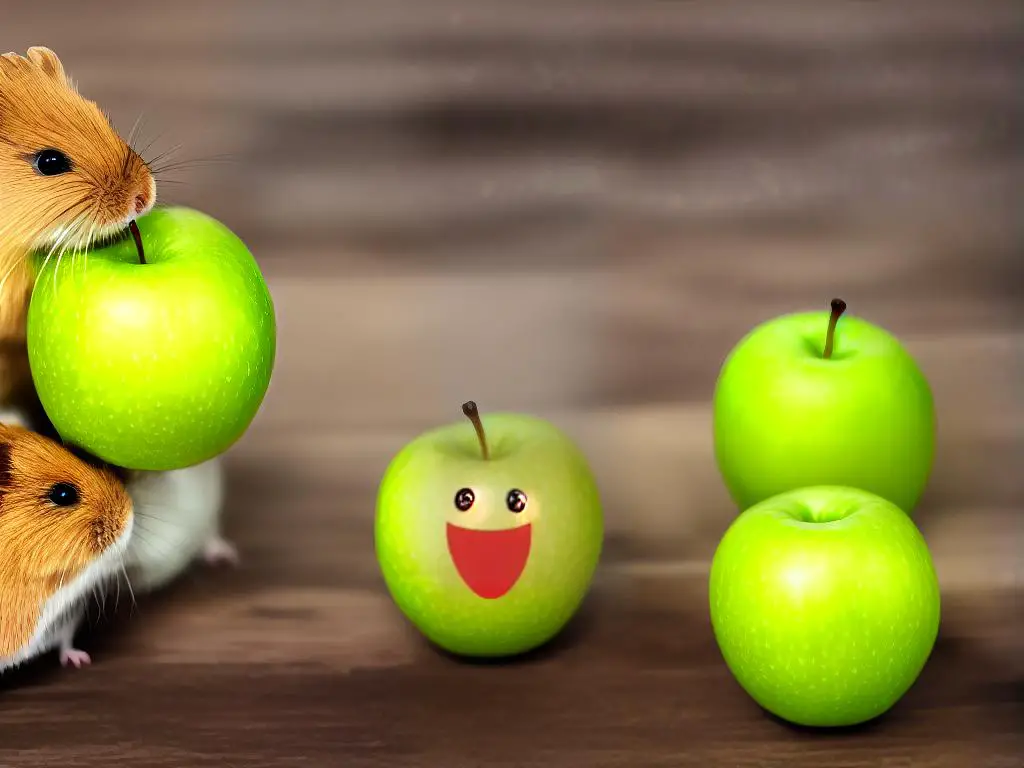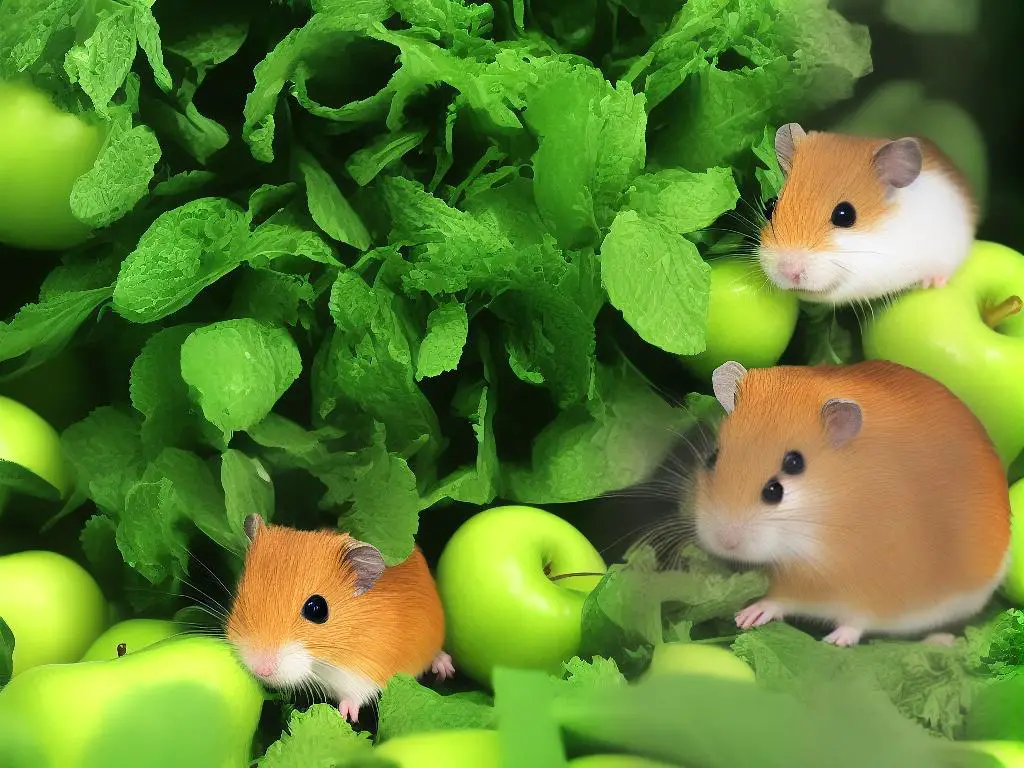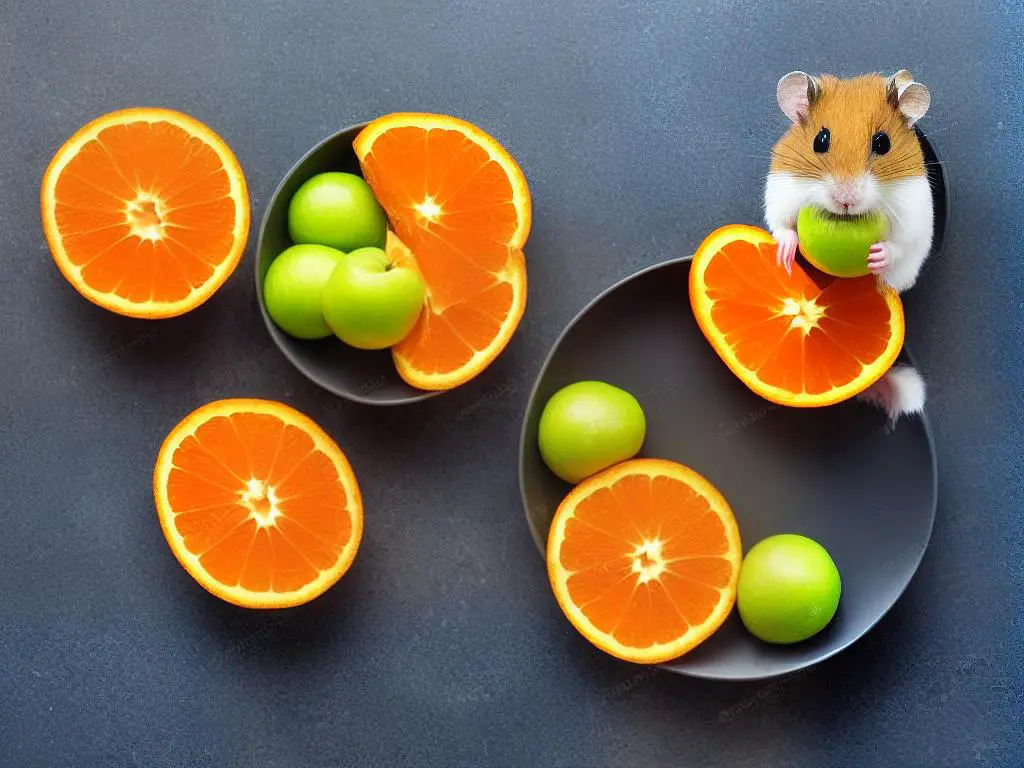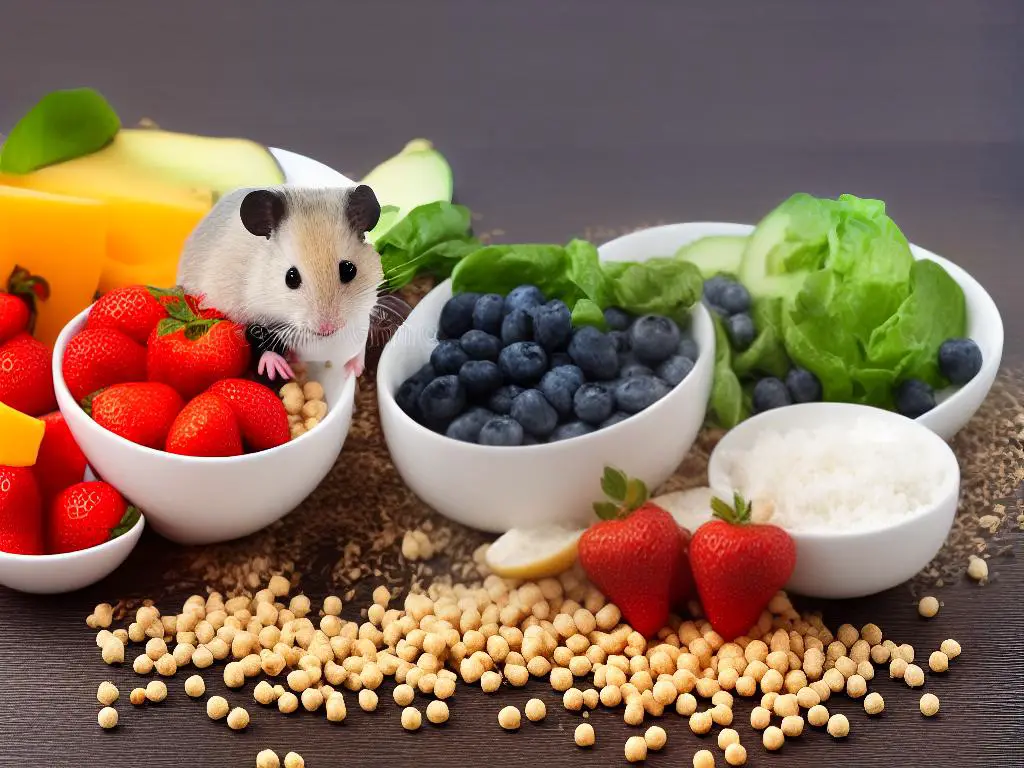Hamsters are popular and adorable pets that require a well-balanced diet to maintain their health and wellbeing. One common question among hamster owners is whether green apples are a safe and nutritious food to include in their pet’s diet. This article aims to provide valuable information on the safety, nutritional content, and potential health concerns associated with feeding green apples to hamsters, as well as how to properly serve them and explore alternative options for feeding a variety of fruits and vegetables to your furry friend.
Green Apples: Are They Safe?
When it comes to feeding hamsters, it is crucial to understand the nutritional needs and restrictions of these small pets. Among the different types of treats we can offer to our furry friends, fruits are often considered beneficial and tasty options. One of these fruits, green apples, raises questions among hamster owners about their safety and suitability as a part of the pet’s diet. In this section, we will discuss the potential benefits, risks, and comparisons to other common hamster fruit treats, all to help you make an informed decision as a responsible pet owner.
Green apples contain various beneficial nutrients suitable for hamsters, including fiber, vitamin C, and potassium. Fiber is essential for maintaining healthy digestion, while vitamin C serves as an antioxidant and strengthens their immune system. Potassium, on the other hand, aids in muscle and nerve function. These nutrients make green apples a healthy treat for your hamster when given in moderation.
Despite the nutritional benefits, there are a few risks to consider when feeding green apples to hamsters. For one, these fruits are known for their acidic nature, which can be harmful to the pet’s digestive system when given in large quantities or too frequently. Moreover, green apples are also high in sugar, which can contribute to diabetes in hamsters, especially the dwarf breeds such as Roborovski.
To mitigate these potential risks, it is advised to offer green apples sparingly, in small quantities, and remove the skin and seeds before feeding. The skin can pose a choking hazard, while the seeds contain trace amounts of cyanide, which is toxic to hamsters. By removing these parts and limiting the frequency of feeding, you can safely provide green apples as an occasional treat.
When considering feeding fruits to hamsters, it is essential to note that there are options with lower sugar content that may be safer for regular feeding. For instance, berries, such as blueberries and strawberries, provide various nutrients with less worry about sugar-induced health issues. Additionally, vegetables like cucumbers and carrots are excellent snack alternatives that offer essential vitamins and minerals without the added sugar content often found in fruits.

Nutritional Content of Green Apples
Although green apples contain higher sugar content, they are a healthy and nutritious fruit that provides a variety of vitamins, minerals, and fiber for hamsters. Some of the most notable nutrients found in green apples include vitamin C, vitamin A, calcium, and potassium. Vitamin C is vital for hamster’s overall health as it aids in tissue growth and repair, immune system support, and may also have antioxidant properties. Vitamin A helps maintain healthy skin, vision, and immune function. Calcium is essential for the development and maintenance of strong bones and teeth, while potassium supports proper nerve and muscle function. Given these benefits, green apples can still be given to hamsters occasionally, in moderation, as part of a balanced diet.
In addition to vitamins and minerals, green apples are also a good source of dietary fiber. Fiber is particularly important for maintaining proper digestion and can be helpful for preventing and alleviating gastrointestinal issues such as constipation and diarrhea. The inclusion of fiber in a hamster’s diet may also contribute to a balanced, healthy weight, as it helps promote satiety and prevents overeating.
When feeding green apples to hamsters, it is important to consider the potential effects of natural sugars found in the fruit. Although sugar is a natural component of many fruits, excessive consumption can lead to obesity and other health issues in pets, including hamsters. Hamsters are prone to develop diabetes, so it is essential to be mindful of their sugar intake. To best manage their intake of natural sugars, offer green apples in moderation as a treat.
It is also crucial to properly prepare green apples before feeding them to hamsters. To minimize potential choking hazards and ease digestion, green apples should be cut into small, bite-sized pieces and offered without the seeds. Apple seeds contain a small amount of cyanide, which can be toxic to hamsters when ingested in large amounts. Therefore, removing the seeds and core of the apple prior to feeding it to a hamster is highly recommended.
In summary, green apples can serve as a healthy and nutritious treat for hamsters, offering essential vitamins, minerals, and fiber. However, it is important to monitor their consumption to avoid potential health issues associated with excessive sugar intake and to properly prepare the apples, ensuring the seeds and core are removed. By providing green apples as an occasional treat rather than a staple food source, you can contribute to your hamster’s overall well-being and perhaps even add some variety and excitement to their diet.

Serving Green Apples to Hamsters
As hamsters are fond of fruits and vegetables, green apples can be an excellent addition to their meal plan. These apples not only provide a nutritious source of vitamins and minerals but also serve as a tasty treat for your tiny pet. To smoothly integrate this snack into their diet, it’s crucial to understand the proper way to serve these apples to your hamster, taking the correct portion size and feeding frequency into account.
When preparing green apples for your hamster, it’s important to wash the fruit thoroughly under running water to remove any pesticides, dirt, or other contaminants. It is also a good idea to opt for organic green apples, as they tend to contain fewer harmful chemicals than their non-organic counterparts. Once the apple is clean, cut off a small portion about the size of a raisin, ensuring there are no seeds or stems present, as these can be a choking hazard for your hamster. Also, avoid feeding your hamster the apple core, as it may contain traces of cyanide.
Before serving the green apple to your hamster, ensure that it’s at room temperature. Hamsters are sensitive to cold temperatures, and a chilled apple could cause discomfort or digestive issues. It’s also essential to cut the fruit into small, bite-sized pieces to make it easier for your hamster to eat and avoid any potential choking hazards.
When it comes to portion size, moderation is key; it’s essential not to overfeed your hamster with green apples or any other fruit or vegetable. As a general rule of thumb, a small slice or a piece about the size of a raisin should be sufficient for your hamster. Additionally, be sure to remove any uneaten apple pieces from your hamster’s cage within 24 hours to prevent mold and bacteria growth, which could be harmful to your pet’s health.
While fruits like green apples may provide valuable nutrients for your hamster, it is essential to remember that they should not serve as a substitute for their regular food. A balanced and complete diet for your hamster should consist of grains, seeds, and protein sources. Fruits and vegetables, including green apples, can be given as occasional treats or supplements to ensure proper nutrition. Aim to rotate these treats between options such as carrots, bell peppers, and cucumber, providing your hamster with a variety of flavors and essential nutrients one or two times a week.

Potential Health Concerns
Green apples, although generally known as safe and nutritious for humans, might present potential health concerns when fed to hamsters. These small creatures have different dietary requirements and sensitivities to certain substances, making it crucial to understand the possible risks associated with giving them green apples. Apples, for example, contain a certain amount of natural sugars. If consumed in large amounts, these sugars could contribute to health issues like diabetes and obesity in hamsters. Therefore, it is important to monitor their intake of sugary fruits and maintain a balanced diet.
One common concern when feeding green apples to hamsters is the possibility of an allergic reaction. Some hamsters may be sensitive or allergic to specific compounds found in green apples, resulting in an adverse reaction upon ingestion. Signs of an allergic reaction in a hamster can include itching, swelling, and difficulty breathing, all of which can quickly become life-threatening. If you suspect that your hamster may be allergic to green apples or any other food, it is essential to remove that item from their diet and consult a veterinarian for further advice.
Another potential health concern related to hamsters consuming green apples is digestive problems. Green apples have relatively high levels of dietary fiber, which can cause gastrointestinal issues such as diarrhea and gas when consumed in large amounts. Therefore, it is crucial to feed only small amounts of green apples to your hamster to avoid any digestive discomfort. Furthermore, the acidity of green apples may upset the hamster’s delicate digestive system, as their stomachs are not designed to process highly acidic foods.
Additionally, the seeds inside apples contain a substance called amygdalin, which gets converted into hydrogen cyanide when ingested. Hydrogen cyanide can be harmful to hamsters if consumed in large quantities. Although a single apple seed may not pose a significant threat to your hamster’s health, it is always better to be on the safer side by removing the seeds before feeding apple pieces to your pet.
Providing a balanced diet for your hamster is crucial for maintaining its overall health. While green apples can be an occasional treat for your furry friend, it is essential to focus on offering a hamster-specific food mix as their main source of nutrition. Hamsters’ nutritional needs may vary depending on factors like breed, size, and age; consulting with a veterinarian or other knowledgeable sources can help ensure that you are meeting the dietary requirements of your pet.

Alternatives to Green Apples
When thinking about the dietary needs of your hamster, consider offering alternative fruits and vegetables in addition to their primary food source. Green apples are a popular choice, but exploring other options can also benefit your pet’s health. This includes learning about the nutritional value of different fruits and vegetables and how they contribute to your hamster’s well-being. By diversifying their diet, you can help promote optimal health and vitality for your hamster.
Blueberries, for example, are an excellent alternative fruit option for hamsters. They are packed with vitamins, fiber, and antioxidants that can strengthen your hamster’s immune system. As with green apples, moderation is key when feeding blueberries to your hamster. Providing a few blueberries once or twice a week, in addition to a balanced diet, can help in maintaining your hamster’s overall well-being.
Cucumbers are another excellent alternative to consider for your hamster. They not only provide hydration but are also low in calories and high in nutritional value. Including cucumbers in your hamster’s diet once or twice a week can help support healthy growth without causing digestive issues. However, it is essential to wash the cucumber thoroughly and remove the seeds before feeding it to your hamster.
Carrots are another nutrient-rich vegetable option that can provide essential vitamins and minerals to your hamster. High in vitamin A and fiber, carrots can help in maintaining good vision and support healthy digestion. It is recommended to feed your hamster small, grated pieces of carrot twice a week. Be careful not to overfeed carrots, as too much vitamin A can be harmful to your hamster.
In conclusion, there are numerous alternative fruits and vegetables to green apples that you can feed your hamster. These alternatives, such as blueberries, cucumbers, and carrots, offer a variety of nutritional benefits that can contribute to your hamster’s overall health. By incorporating these options into your hamster’s diet, you can provide a well-rounded and balanced selection of treats alongside their staple food. Remember always to introduce new foods gradually and in moderation to avoid digestive issues or overfeeding.

Ultimately, while green apples can be a suitable and nutritious treat for hamsters when fed in moderation, it is important to carefully prepare and serve them to ensure the safety and wellbeing of your pet. Understanding the nutritional content, potential health concerns, and suitable alternatives for feeding a well-rounded diet to your hamster will enable you to make informed decisions when offering fruits and vegetables, contributing to a happy and healthy hamster.